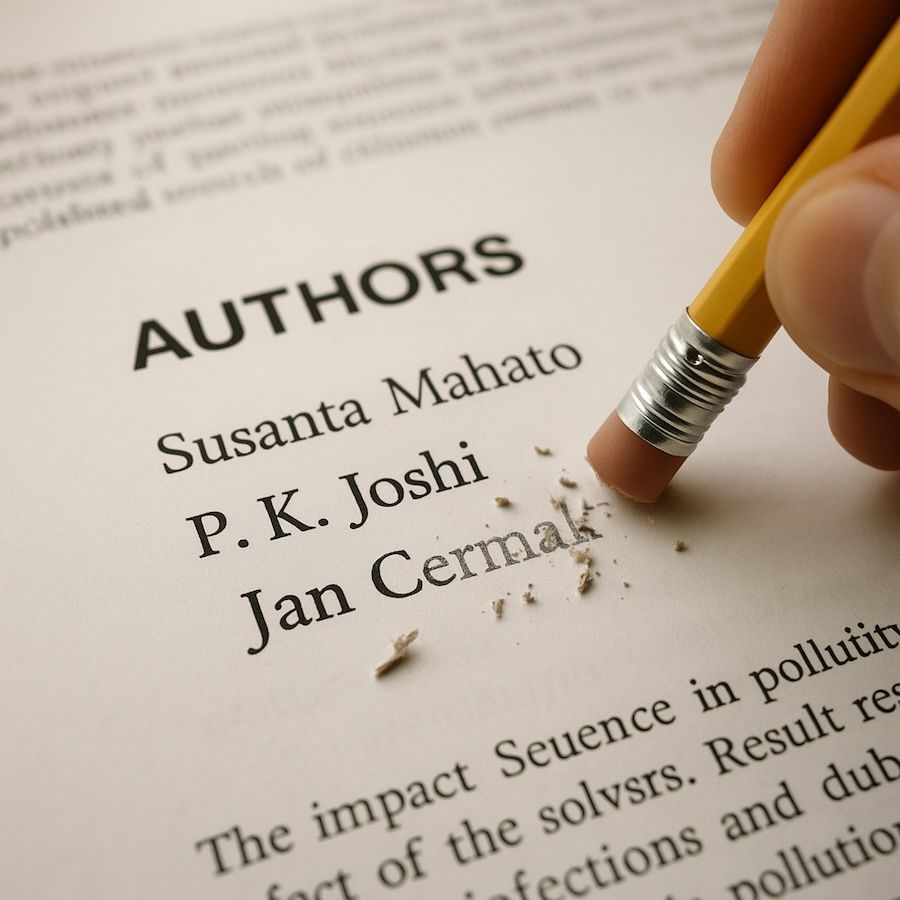When You Discover You Are the Author of a Paper You Never Wrote
-

The Incident
Imagine waking up to find yourself listed as the co-author of a scientific paper you never even heard of. That was the shocking reality for Jan Cermak, a climate scientist at Karlsruhe Institute of Technology (KIT). He recently discovered his name attached to an article in Chemosphere, a paper he neither contributed to nor approved. The study, which analyzed meteorological effects on air pollution in India, was eventually retracted due to authorship fraud.
The corresponding author, Susanta Mahato (an assistant professor at Harisingh Gour University in India and former visiting scholar in Cermak’s lab), had submitted the manuscript using incorrect email addresses for Cermak and another listed co-author, P.K. Joshi. While Joshi consented, Cermak was left entirely unaware. To make matters worse, Mahato allegedly submitted a forged email claiming Cermak’s approval. Elsevier, the publisher, confirmed that once a paper is published, removing an author’s name is not an option — forcing a full retraction.
The Bigger Picture
This is not an isolated case. The phenomenon of ghost or forged authorship has appeared across disciplines. In early 2025, other researchers publicly reported feeling “professionally insulted” after being unknowingly listed on papers. In some cases, attempts to remove names yielded inconsistent results: some journals allowed it, while others only permitted withdrawal of the entire article.
Mahato himself has been associated with multiple irregularities. In May 2025, a Springer journal had to issue a correction replacing KIT with a different institutional affiliation on one of his papers. Similar fraudulent authorship has been reported in U.S. Department of Agriculture labs, where visiting scholars lost publication credits due to unauthorized co-authorship.
What This Implies
The implications are deeply troubling for the research ecosystem:
- Integrity of Authorship: Authorship is more than a name; it is a statement of responsibility, contribution, and accountability. Forged authorship dilutes trust in scientific credit systems.
- Journal Vulnerabilities: This case highlights systemic flaws in editorial workflows, particularly in verifying author identities and ensuring informed consent.
- Professional Harm: Being falsely listed can damage reputations, especially if the article is later associated with misconduct, conflict of interest, or poor scholarship.
- Broader Trust in Science: Incidents like this erode confidence not only in publishers but also in the peer-review system as a whole.
Possible Solutions
Scholarly publishing has long grappled with “authorship inflation” and “honorary authors.” Yet this case underscores the urgent need for technical safeguards:
- Institutional Email Verification: Require all listed authors to confirm participation through their verified academic or institutional accounts.
- Transparent Contribution Records: Adoption of standardized frameworks (e.g., CRediT taxonomy) with auditable logs.
- Direct Journal-Author Contact: Journals must independently verify consent with all authors prior to acceptance.
- Stronger Sanctions: Authors proven guilty of deliberate authorship fraud should face formal bans or blacklisting across publishers.
Closing Thoughts
What happened to Cermak is a reminder that in the digital era, the scientific community is vulnerable not just to plagiarism or data manipulation, but also to identity abuse. Unless stronger checks are established, researchers may continue to wake up as “authors” of papers they never wrote—an absurd reality that undermines the very credibility of science itself.
Reference:
[1] Retraction Watch. Forged authorship leads to Chemosphere retraction. (2025). Link
